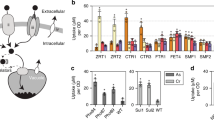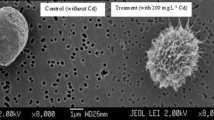Abstract
Bioremediation of heavy metals by using microorganisms is an effective strategy in regions that have low and wide-ranging metal concentrations and in situations where physical and chemical techniques are not suitable. Because of their higher capacity to remove a wide range of metals by biosorption, yeasts are useful for the bioremediation of heavy metals. In this study, identification of yeast mutants (CdRs) was focused, which have strong resistance to cadmium (Cd), a representative heavy metal. Yeast cells were sequentially adapted to gradually increasing the Cd concentration up to 30 mM. The resultant mutant, CdR30 cells survived a final Cd concentration of 30 mM, while the control cells failed to survive at 0.5 mM in 7 d. It was analyzed whether the increased Cd tolerance of the mutants was associated with sensitivity toward other metals. Compared to control cells, CdR20 cells showed increased tolerance to Cu, decreased tolerance to Ni, and comparable tolerance to Zn. However, these tolerances were not reproducible, because CdRs isolated in a second round of induction showed different metal sensitivities. The increase in Ni sensitivity in CdR20 cells was overcome by performing a second adaptation to Ni stress. Thus, CdR20 cells that were tolerant to both Cd and Ni were generated. These data presented in this study may be useful for the application of microorganisms to the bioremediation of heavy metals.
Similar content being viewed by others
References
Díaz-Raviña M and Bååth E. (1996) Development of metal tolerance in soil bacterial communities exposed to experimentally increased metal levels. Appl Environ Microbiol 62, 2970–7.
Díaz-Raviña M and Bååth E. (2001) Response of bacterial communities preexposed to different metals and reinoculated in an unpolluted soil. Soil Biology Biochemistry 33, 241–8.
Duxbury T and Bicknell B. (1983) Metal-tolerant bacterial populations from natural and metal-polluted soils. Soil Biol Biochem 15, 243–50.
Gad AS, Attia M, and Ahmed HA. (2010) Heavy metals bio-remediation by immobilized Saccharomyces cerevisiae and Opuntia ficus indica waste. J American Sci 6, 79–87.
Gaur N, Flora G, Yadav M, and Tiwari A. (2014) A review with recent advancements on bioremediation-based abolition of heavy metals. Environ Sci Proceses Impacts 16, 180–93.
Giaginis C, Gatzidou E, and Theocharis S. (2006) DNA repair systems at targets of cadmium toxicity. Toxicol Appl Pharmacol 213, 282–90.
Jin YH, Clark AB, Slebos RJ, Al-Rafai H, Taylor JA, Kundel TA, Resnick MA, and Gordenin A. (2003) Cadmium is a mutagen that acts by inhibiting mismatch repair. Nat Gen 34, 326–9.
Lee S and Kim JH. (2010) Establishment of tolerance to both cadmium and copper stress by expressing Arabidopsis phytochelatin synthase in Cu tolerant yeast mutant. J Korean Soc Appl Biol Chem 53, 94–6.
Rehman A, Farooq H, and Hasnain S. (2008) Biosorption of copper by yeast, Loddermyces elongisporus, isolated rom industrial effluents: its potential use in wastewater treatment. J Basic Microbiol 48, 195–201.
Ruta L, Paraschivescu C, Matache M, Avramescu S, and Farcassanu IC. (2010) Removing heavy metals from synthetic effluents using “kamikaze” Saccharomyces cerevisiae cells. App Microbiol Biotechnol 85, 763–71.
Serero A, Lopes J, Nicolas A, and Boiteux S. (2008) Yeast genes involved in cadmium tolerance: Identification of DNA replication as a target of cadmium toxicity. DNA Repair 7, 1262–75.
Soares EV and Soares HM. (2012) Bioremediation of industrial effluents containing heavy metals using brewing cells of Saccharomyces cerevisiae as a green technology: a review. Environ Sci Pollut Res Int 19, 1066–83.
Villegas LB, Amoroso MJ, and de Figueroa LIC. (2005) Copper tolerant yeasts isolated from polluted area of Argentina. J Basic Microbiol 45, 381–91.
Wuana RA and Okieimen FE. (2011) Heavy metals in contaminated soils: a review of sources, chemistry, risks and best available strategies for remediation. ISRN Ecology 2011, 1–20.
Zafar S, Aquil F, and Ahmad I. (2007) Metal tolerance and biosorption potential of filamentous fungi isolated from metal contaminated agricultural soil. Bioresource Technology 98, 2557–61.
Author information
Authors and Affiliations
Corresponding author
Rights and permissions
About this article
Cite this article
Lee, S. Characterization of artificially induced cadmium-tolerant yeast mutants. J Korean Soc Appl Biol Chem 57, 545–549 (2014). https://doi.org/10.1007/s13765-014-4114-0
Received:
Accepted:
Published:
Issue Date:
DOI: https://doi.org/10.1007/s13765-014-4114-0




